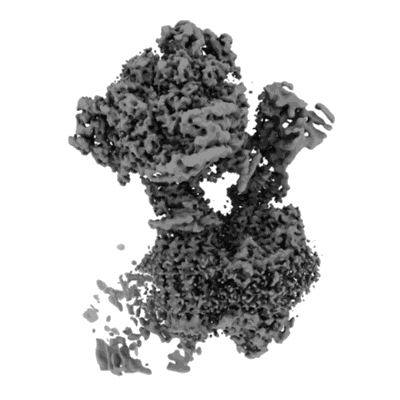EMD-15571
rotational state 2c of the Trypanosoma brucei mitochondrial ATP synthase dimer
EMD-15571
Single-particle3.8 Å
 Deposition: 09/08/2022
Deposition: 09/08/2022Map released: 26/10/2022
Last modified: 26/10/2022
Sample Organism:
Trypanosoma brucei brucei
Sample: mitochondrial ATP synthase dimer from Trypanosoma brucei
Fitted models: 8aph (Avg. Q-score: 0.158)
Deposition Authors: Muehleip A, Gahura O ,
Zikova A
,
Zikova A  ,
Amunts A
,
Amunts A 
Sample: mitochondrial ATP synthase dimer from Trypanosoma brucei
Fitted models: 8aph (Avg. Q-score: 0.158)
Deposition Authors: Muehleip A, Gahura O
 ,
Zikova A
,
Zikova A  ,
Amunts A
,
Amunts A 
An ancestral interaction module promotes oligomerization in divergent mitochondrial ATP synthases.
Gahura O  ,
Muhleip A
,
Muhleip A  ,
Hierro-Yap C,
Panicucci B,
Jain M
,
Hierro-Yap C,
Panicucci B,
Jain M  ,
Hollaus D
,
Hollaus D  ,
Slapnickova M,
Zikova A
,
Slapnickova M,
Zikova A  ,
Amunts A
,
Amunts A 
(2022) Nat Commun , 13 , 5989 - 5989
 ,
Muhleip A
,
Muhleip A  ,
Hierro-Yap C,
Panicucci B,
Jain M
,
Hierro-Yap C,
Panicucci B,
Jain M  ,
Hollaus D
,
Hollaus D  ,
Slapnickova M,
Zikova A
,
Slapnickova M,
Zikova A  ,
Amunts A
,
Amunts A 
(2022) Nat Commun , 13 , 5989 - 5989
Abstract:
Mitochondrial ATP synthase forms stable dimers arranged into oligomeric assemblies that generate the inner-membrane curvature essential for efficient energy conversion. Here, we report cryo-EM structures of the intact ATP synthase dimer from Trypanosoma brucei in ten different rotational states. The model consists of 25 subunits, including nine lineage-specific, as well as 36 lipids. The rotary mechanism is influenced by the divergent peripheral stalk, conferring a greater conformational flexibility. Proton transfer in the lumenal half-channel occurs via a chain of five ordered water molecules. The dimerization interface is formed by subunit-g that is critical for interactions but not for the catalytic activity. Although overall dimer architecture varies among eukaryotes, we find that subunit-g together with subunit-e form an ancestral oligomerization motif, which is shared between the trypanosomal and mammalian lineages. Therefore, our data defines the subunit-g/e module as a structural component determining ATP synthase oligomeric assemblies.
Mitochondrial ATP synthase forms stable dimers arranged into oligomeric assemblies that generate the inner-membrane curvature essential for efficient energy conversion. Here, we report cryo-EM structures of the intact ATP synthase dimer from Trypanosoma brucei in ten different rotational states. The model consists of 25 subunits, including nine lineage-specific, as well as 36 lipids. The rotary mechanism is influenced by the divergent peripheral stalk, conferring a greater conformational flexibility. Proton transfer in the lumenal half-channel occurs via a chain of five ordered water molecules. The dimerization interface is formed by subunit-g that is critical for interactions but not for the catalytic activity. Although overall dimer architecture varies among eukaryotes, we find that subunit-g together with subunit-e form an ancestral oligomerization motif, which is shared between the trypanosomal and mammalian lineages. Therefore, our data defines the subunit-g/e module as a structural component determining ATP synthase oligomeric assemblies.
